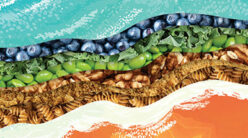New research confirms what nutritionists have said for years–eating lots of high-fiber foods is a great way to protect your health. That might sound like an outrageous claim. But according to researchers conducting the biggest-ever study into the relationship between diet and cancer, it’s the truth. For 15 years the European Prospective Investigation of Cancer and Nutrition (EPIC) has examined the dietary habits of more than 400,000 people in nine European countries. EPIC researchers released preliminary results from their long-term cohort study at a nutrition conference last year in Lyons, France.
Among other findings, the researchers determined that fiber is particularly important in reducing the risk of colorectal cancer, the second-leading cause of cancer-related death in the United States. “We placed 400,000 people on the study into five sets according to their consumption of fiber,” explains Professor Sheila Bingham of the Dunn Human Nutrition Unit at Cambridge University. “The group eating the most fiber reduced their risk of colorectal cancer by as much as 40 percent.”
The EPIC findings appear to confirm what many nutritionists have said about fiber for decades. Nonetheless, you might remember headlines from a couple of years ago warning that fiber is “useless” as protection against colorectal cancer. So what gives?
Mixed Messages
These cautionary health bulletins came in response to studies calling the protective role of fiber into question. One of the sharpest blows to fiber’s reputation came in 1999 when the New England Journal of Medicine published results from the Nurses’ Health Study. This research–an analysis of the diet and disease patterns of 89,000 male and female nurses–found that participants who ate the largest amount of fiber did not reduce their risk for colon cancer.
“We have long touted and believed in the protective role of fiber, so that study was a little disconcerting,” says Kathleen Zelman, a registered dietitian and Atlanta-based spokesperson for the American Dietetic Association. “How-ever, we didn’t change our recommendations, because you don’t do that based on one or two studies.”
In fact, some critics of the “anti-fiber” findings pointed to certain shortcomings in the way the research was conducted. Meanwhile, other studies highlighted fiber’s protective properties. A Harvard University team, for example, found that certain enzymes derived from fiber have the ability to block the colon cancer process.
Researchers with the EPIC project–which produced the first positive results about fiber from such a large group–say its sheer scope goes a long way toward clearing up the confusion. Those positive results were no surprise to Bingham, a leading expert on fiber. “There are very good mechanisms whereby fiber protects against colorectal cancer,” she says.
Benefits Galore
Some might feel the jury is still out on fiber’s role as a cancer fighter. Nonetheless, given the many benefits of high-fiber foods like whole grains, fruits, and vegetables, the arguments for adding more fiber to your diet are overwhelming. A high-fiber diet can reduce levels of blood cholesterol, help maintain regularity, and fend off gastrointestinal conditions such as diverticulitis.
Unlike their processed counterparts, such as white rice or white bread, whole-grain foods retain their original fiber, the nutrient-rich bran and germ, and the starchy endosperm. That might sound academic, but from a nutritional standpoint it makes a big difference.
“Processing whole grains to create a refined grain removes most of their nutritional content,” says Verne Varona, a nationally known health educator and author of Nature’s Cancer-fighting Foods. “People mistakenly believe that the laws requiring white flour to be enriched compensate for the many valuable nutrients lost during processing. It’s true that a few synthetic vitamins and minerals are added to our white flour, but this doesn’t even come close to restoring all the lost nutrients.”
Whole wheat, for example, contains calcium, iron, magnesium, phosphorus, sodium, zinc, copper, manganese, and selenium. It also has ascorbic acid, thiamin, riboflavin, niacin, pantothenic acid, vitamin B6, folate, and vitamin E. “Most of these nutrients are in the bran and wheat germ and are stripped out during processing,” Varona notes. The milling process also removes hundreds of other phytochemicals that may help reduce risk for cancer, diabetes, and heart disease.
Whole Grains: The Perfect Carbs
The body converts all carbohydrates into glucose. But it breaks down processed grains much more quickly than intact grains. The rapid breakdown of processed carbohydrates often causes wide swings in blood sugar that can trigger hunger cravings, cause the release of stress hormones, and initiate the buildup of arterial plaques. Varona compares foods made from refined grains to quick-burning newspaper. Whole grains, on the other hand, are like logs that burn for hours and provide continuous heat.
Common whole grains include brown rice, barley, millet, oats, buckwheat, rye, and whole wheat. You might also want to experiment with traditional Native American grains such as quinoa (“keen-wa”) or amaranth, available in health- food stores. Good whole-grain recipes are easy to find on the Internet. But enjoying these highly nutritious foods can require patience–whole grains generally take longer to cook than refined grains.
Adopting the Right Diet
So what’s the best way to boost the amount of fiber in your diet? And how much is enough? In the EPIC study, those who enjoyed the most protection from colorectal cancer ate at least 50 percent more fiber than their counterparts. This is in line with current recommendations to increase your fiber intake by 50 percent. Following the National Cancer Institute’s “5 A Day” recommendations–which suggest eating five servings of fruits and vegetables a day–is another excellent way to boost fiber intake.
“There’s no fat in fruits or vegetables, and they’re loaded with vitamins, minerals, and phytochemicals–all kinds of things that are beneficial for preventing cancer,” says Zelman. “Another great way to boost fiber intake is to start the day with a cereal that has the word `bran’ in the title. A bran-based cereal generally gives you the most fiber out of typical breakfast cereals.”
But be careful. Many breads and breakfast cereals that contain next to nothing in the way of whole grains are misleadingly labeled as being “multi-grain” or having “natural grain goodness.” If the package doesn’t say “100 percent whole grain by weight” or “100 percent whole wheat,” take a closer look at the label. The most plentiful ingredients in a food are always listed first. So if the first ingredient listed is “whole oats,” that food is made from whole grains. If “whole oats” comes ninth on the list, you’ve got an impostor.
To guarantee adequate dietary fiber, Varona suggests eating at least one cup of whole grains each day. “This could be a cup of rolled oats, cooked with water and with added toppings of roasted almonds, cinnamon, or a small amount of raisins,” he says. “I’d also recommend brown rice, which is great with dinner entrées, or barley, which is wonderful in soups with vegetables or mixed with legumes such as lentils.”
The point is to enjoy better health and better-tasting food simultaneously. Once you’ve experienced the rich, nutty flavor of fresh whole-grain bread, you’ll save the white stuff for the ducks.






